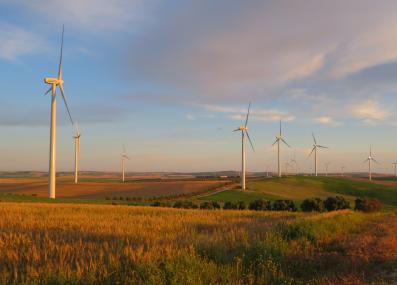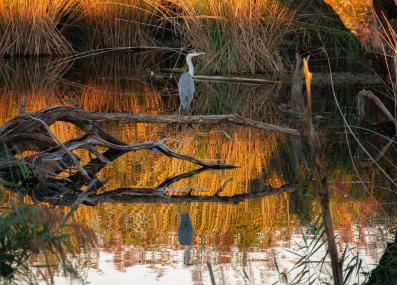Have a question?
Do wind turbines kill birds?
Yes—but only a fraction as many as are killed by house cats, buildings, or even the fossil fuel operations that wind farms replace.
Updated December 12, 2023
Wind turbines have long garnered scrutiny for killing birds that fly into their spinning blades or tall towers. Much of the data about bird deaths at wind facilities in the United States comes from studies published in 2013 and 2014. Those studies gave a wide range for the number of birds that die in wind turbine collisions each year: from 140,000 up to 679,000.1 The numbers are likely to be higher today, because many more wind farms have been built in the past decade.2
Those numbers are not insignificant, but they represent a tiny fraction of the birds killed annually in other ways, like flying into buildings or caught by prowling house cats, which past studies have estimated kill up to 988 million3 and 4 billion4 birds each year, respectively. Other studies have shown that many more birds—between 12 and 64 million each year—are killed in the U.S. by power lines, which connect wind and other types of energy facilities to people who use the electricity.5
Other sources of electricity are also more lethal for birds than wind energy. A 2012 study found that wind projects kill 0.269 birds per gigawatt-hour of electricity produced, compared to 5.18 birds killed per gigawatt-hour of electricity from fossil fuel projects.6 That’s in part due to collisions with equipment (wind turbines aren’t the only energy infrastructure birds can fly into), but mostly because of the environmental impact of fossil fuels. Coal mining has torn down forests and destroyed habitat, and burning coal produces air pollution tied to acid rain and mercury contamination, which scientists have linked to bird health impacts like birth defects. But when it comes to bird deaths, the most significant impact from fossil fuels is their contribution to climate change, which scientists expect will be extremely dangerous for birds. The National Audubon Society estimates that about two-thirds of bird species in North America are at increased risk of extinction due to rising temperatures and changes to the habitat where they live.7
“When assessing electricity generation technologies, it’s important to evaluate against baseline generation alternatives, because electricity generation is a requirement of modern society,” says Michael Howland, MIT professor of civil and environmental engineering. “Fossil fuels contribute to climate change, increased air pollution, and negative impacts on human and animal health, including birds, among other issues. Wind energy is an electricity generation technology that significantly reduces such environmental and health impacts.”
Still, scientists and conservationists are actively working to minimize bird interactions at wind facilities. “Environmental impact studies” are conducted before the construction of large infrastructure projects, including wind farms, and are meant to ensure projects are not sited in locations that pose a risk to protected species. Researchers are still trying to understand all of the reasons why birds may crash into turbines, such as poor visibility or migration patterns.8 Some conservation biologists are studying how specific species and migration routes are affected by wind facilities, and if wind farms built in certain places may have an outsized impact on vulnerable bird populations.
There are also ways to build safer wind farms for birds. Before construction, wind companies survey sites, and can place fewer turbines in areas most important for habitat, or leave those areas alone entirely. Scientists have found that painting one blade of a turbine black, which can increase visibility, can reduce bird fatalities by more than 70 percent.9 And some wind companies are experimenting with using artificial intelligence to sense a bird’s approach, powering turbines down to avoid collisions.10
Thank you to Julie Grant of Rowland Heights, California, for the question. You can submit your own question to Ask MIT Climate here.
1 Loss, Scott R., Tom Will, and Peter P. Marra, "Estimates of bird collision mortality at wind facilities in the contiguous United States." Biological Conservation, Volume 168, 2013, doi:10.1016/j.biocon.2013.10.007; Erickson, Wallace P., et al., "A Comprehensive Analysis of Small-Passerine Fatalities from Collision with Turbines at Wind Energy Facilities." PLoS ONE, Volume 9, Issue 9, 2014, doi:10.1371/journal.pone.0107491; Smallwood, K. Shawn, "Comparing bird and bat fatality-rate estimates among North American wind-energy projects." Wildlife Society Bulletin, Volume 37, Issue 1, 2013, doi:10.1002/wsb.260.
2 U.S. Energy Information Administration: "Wind Explained." Accessed August 17, 2023.
3 Loss, Scott R., et al., "Bird–building collisions in the United States: Estimates of annual mortality and species vulnerability." The Condor, Volume 116, Issue 1, 2014, doi:10.1650/CONDOR-13-090.1.
4 Loss, Scott R., Tom Will, and Peter P. Marra, "The impact of free-ranging domestic cats on wildlife of the United States." Nature Communications, Volume 4, 2013, doi:10.1038/ncomms2380.
5 Loss, Scott R., Tom Will, and Peter P. Marra, "Refining Estimates of Bird Collision and Electrocution Mortality at Power Lines in the United States." PLoS ONE, Volume 9, Issue 7, 2014, doi:10.1371/journal.pone.0101565.
6 Sovacool, Benjamin K., "The avian benefits of wind energy: A 2009 update." Renewable Energy, Volume 49, 2013, doi:10.1016/j.renene.2012.01.074.
7 Bateman, Brooke, et al., "North American birds require mitigation and adaptation to reduce vulnerability to climate change." Conservation Science and Practice, Volume 2, Issue 8, 2020, doi:10.1111/csp2.242. Summarized in "Survival by Degrees: 389 Bird Species on the Brink," National Audubon Society.
8 Marques, Ana Teresa, et al., "Understanding bird collisions at wind farms: An updated review on the causes and possible mitigation strategies." Biological Conservation, Volume 179, 2014, doi:10.1016/j.biocon.2014.08.017.
9 Nygård, Torgeir, et al., "Paint it black: Efficacy of increased wind turbine rotor blade visibility to reduce avian fatalities." Ecology and Evolution, Volume 10, Issue 16, 2020, doi:10.1002/ece3.6592.
10 "To protect birds, wind industry turns to artificial intelligence," Justin Horwath, S&P Global Market Intelligence, February 4, 2021.







